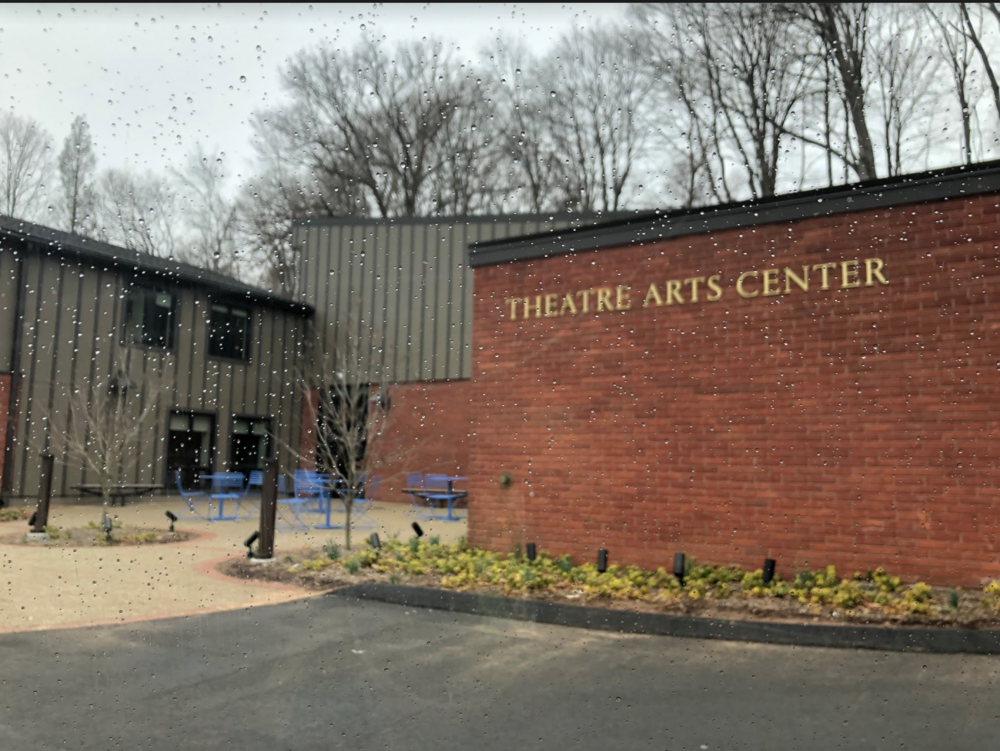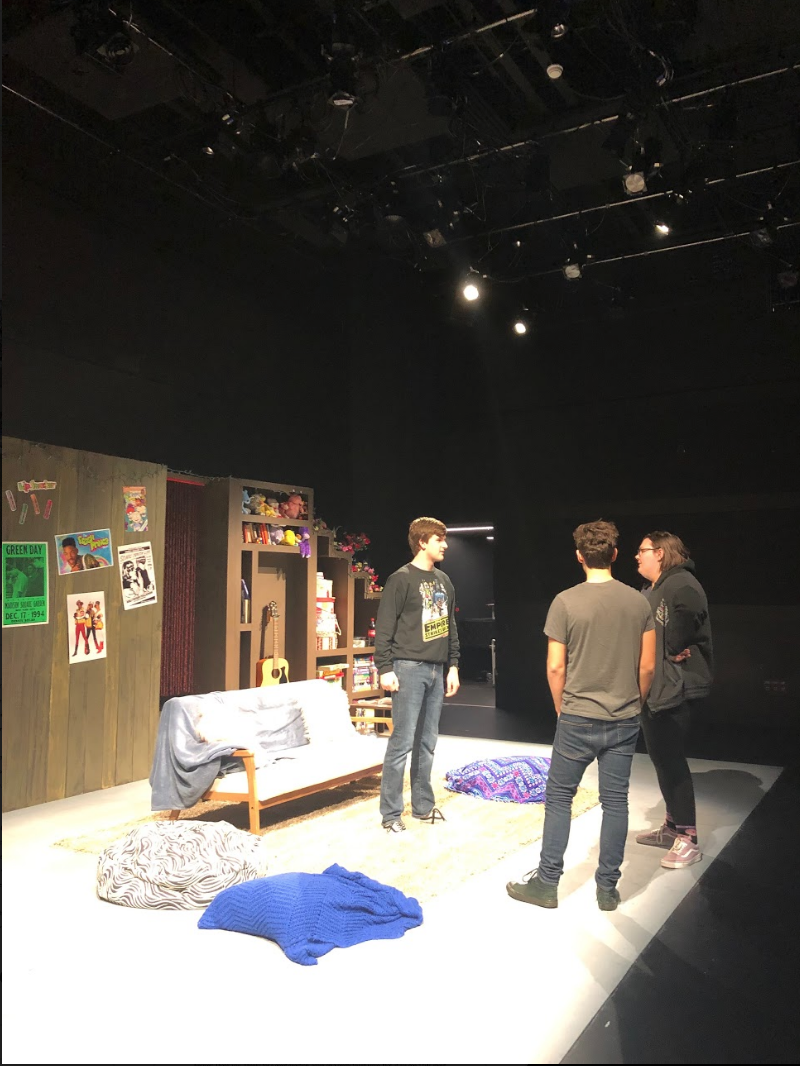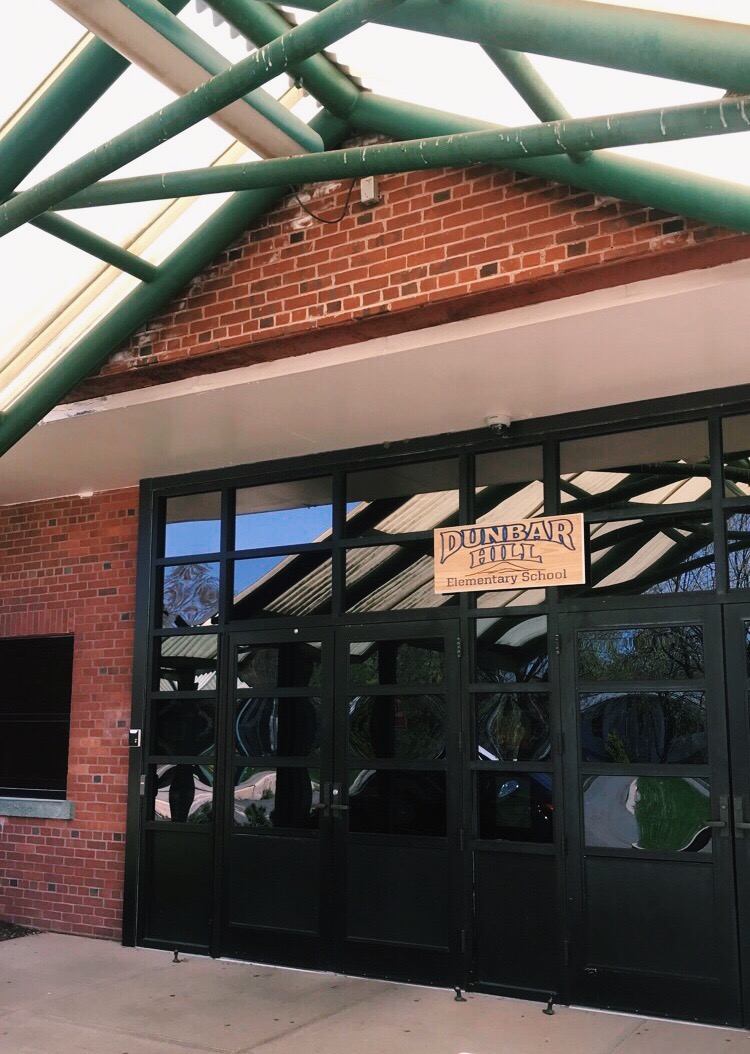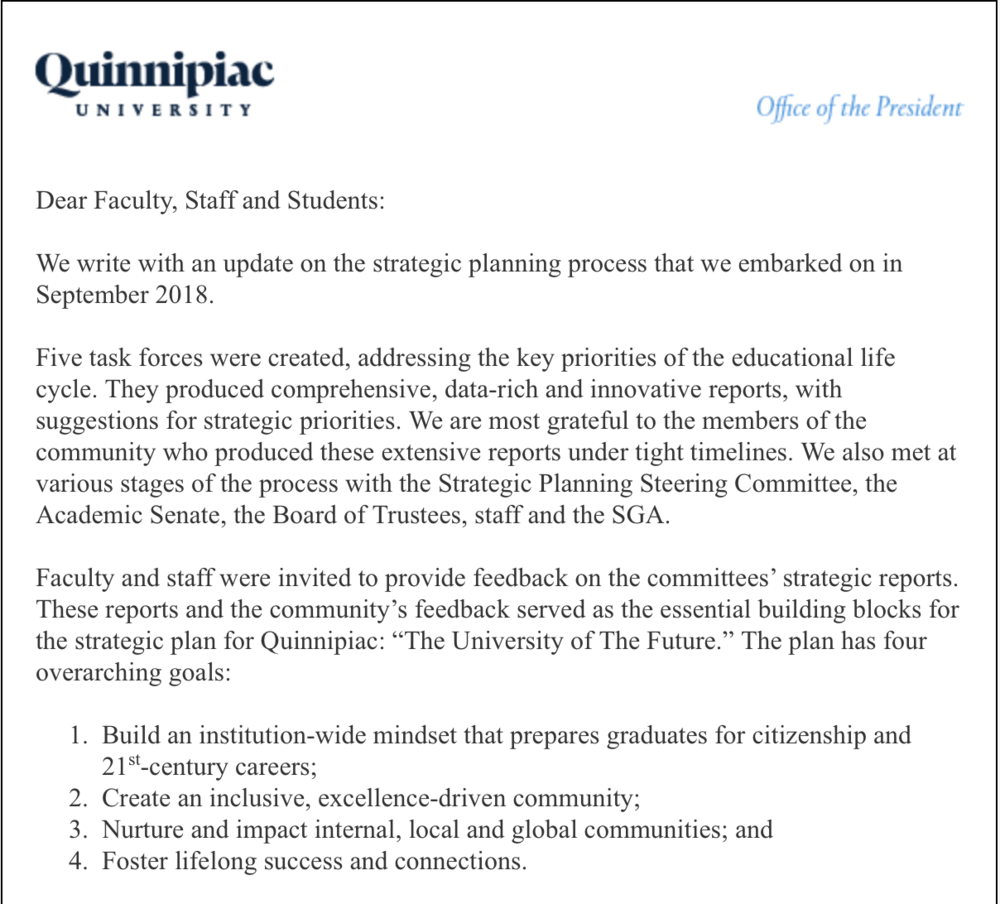
Drama department’s rehearsal space on Sherman Ave
The air is particularly charged within the dim black box theater on 515 Sherman Ave. It is 6:30 p.m. sharp on Wednesday, February 27 with exactly one hour till show time. Stage crew hands run in and out of the space, adding last minute details to the set, which so far includes a series of wooden beams that raise the main stage up high above the soon-to-arrive audience members. A soft blue light filters in from the lighting sets that decorate the entire theater ceiling. Actors dressed in variations of button-ups, dress pants and suits stand clustered in a loose circle of optimum zen and focus, carrying out a series of scales, trimming, humming and other warm-up vocalizations.

The new black-box theater on opening night of ‘Next to Normal’
This is the scene that takes place before Quinnipiac University’s theater department debuts its highly-awaited musical “Next to Normal.”
QU junior Amanda Bushman, who will star in this spring’s student-run production of “Seven Minutes in Heaven,” was in attendance on opening night and she said the audience seemed to wholeheartedly enjoy the show.
“I definitely saw a lot of people crying at the end, including myself,” Bushman said.
It turns out there was a lot of crying that week as all five nights of the show were sold out.“Next to Normal” is the eighth student-run production in the recently converted Theater Arts Center.
What was merely a vacant building 18 months ago is now a fully-furnished space for the dramatic arts. The theater program produces three shows a year within this space and the student theater company produces and additional two of their own on top of that. Including “Midsummer Night’s Dream” and “Little Shop of Horrors,” the music program also holds its concert series here each semester. Many productions now take place in the new Theater Arts Center, the likes of which also see the rehearsal for the new play festival which the student theater company eventually takes to New York.
But back in 2016, when the stages of planning had only just begun, none of this was yet possible at QU.
“We had this building and we had this opportunity. Instead of just doing a one-space black box theater, we could create a whole department,” Sal Filardi of facilities and capital planning said.
Over the following months, the theater program such plans come to fruition. Complete with new lighting and design sets, dressing rooms and a larger, more impressive black box theater, Quinnipiac’s drama department has a new performance space, and it’s one that students and staff say blows the previous tiny black box theater located in the College of Arts and Science out of the water.
“It’s more than just a classroom we painted black,” Filardi said, referring to the CAS black-box theater. “There’s a practice theater, faculty offices, student spaces, a gallery and lobby space, scene shops, costume shops, dressing rooms– it’s a complete facility.”

Location of Theater Arts Center on Sherman Ave
While Quinnipiac University has owned the building on 515 Sherman Ave. since purchasing the property in 1974, it was not until the summer of 2017 that it was developed into a space for the arts. Before then, the school used it to fulfill a variety of different needs. Its most recent purposes included classroom space and furniture storage as well as Hamden fire and police training.
After a year of planning, the theater department officially moved in during August 2017. Students involved in theater say that they could not be more pleased with the new building. Paige Parton, president of the student run theater company, Fourth Wall, experienced the transition first-hand.
“Coming from Buckman and the old CAS black box theater to the theatre arts center was a huge shift and it took a little adjusting – especially with having more classrooms, a design studio and a fully equipped shop, which we had never had before,” Parton said. “We also have a professional looking lobby. It’s a nice touch.”
With such nice touches costing a total of $ 5.5 million, facilities saw entire project as a real investment in the arts. An investment that’s paid off. Now, a little over a year and a half following the move, QU’s theater program and department has seen an upward trajectory in terms of growth and overall enthusiasm.
Quinnipiac has always largely been viewed as a sports school. However, since the conversion of the building, QU has seen a peaked interest in its underdog of departments – the theater arts. The incoming class in fall 2016 had a total of four theater majors; the following year it had three. In fall 2018, the first year of the new theater arts center, the theater department acquired 12 new majors.
Kevin Daly, QU theater program director and assistant professor of theater, said he could not deny the correlation between the timing of getting the building and the sudden surge in numbers.
“I certainly wouldn’t call it a coincidence,” Daly said. “I do think that it has to do with not only the building but also the spirit of a commitment to theater.”
At the same time that the department obtained the new building, it added two more faculty staff members. It has also since developed new programming. There is now an accelerated 3+1 theater degree program with the School of Business where students can receive both a theater degree and a Master of Business Administration.
“I think all of those things converged along with what I think was a really strong commitment from the College of Arts and Sciences and from the university that this was important,” Daly said.
With all the added weight a new building carries in terms of dedication to the arts, the space has proven to be more than a space for performance and rehearsal. For many drama students, it’s a place for both solo and group study sessions as well as a place to come for peace and quiet. Every theater major can use his or her Q-card to access the building during study hours.
“I’ll come here and study,” QU senior Connor Whiteley said. “If I have two classes with a few hours in between, instead of hanging out at the library, I’ll come here.”
Whitely, who starred in “Next to Normal,” is a double major in theater and economics. Prior to this most recent musical, he was in two productions in the fall semester as well as a musical last spring and even directed the student run play last semester. As someone writing a full-length play for his senior project and directing his own production for the Spring festival, Whiteley is highly involved in the QU theater space, and as such, has been thrilled to see it thrive.
“We have more of a presence now. A lot people assume there aren’t really any arts at Quinnipiac but I think having our own building kind of sets us apart.”
He is not alone in this way of thinking. Parton, who is directing “Seven Minutes in Heaven” as well as her own play in the spring festival, saw the building as a sign of further legitimacy. “Since we got the new space our Quinnipiac community has started to take us more seriously, attends the productions and sees that we have a talented and hard working program,” Parton said.
And while there is no denying the obvious benefits of the building as well as the push to establish a larger theater and arts presence, there is also the question of who will notice.
As far as putting QU on the map for theater, realists like Kevin Daly do not believe we should be kidding ourselves by comparing Quinnipiac to schools with more concentrated theater programs.
“I don’t think we should ever strive to be that. What we offer is not a conservatory experience,” Daly said.
According to Daly, QU’s program is one committed to a Bachelor of Arts in theater or a theater studies degree where a student spends about one third of their education in theater. Almost half of the university’s theater majors are double majors who have the ability to explore other disciplines.
“If a student commits to a conservatory style program, almost 75%, maybe more of their education is not only in theater but in a very specific discipline in theater like acting or directing or lighting design,” Daly said. “That’s great if the student knows at 17 or 18 years old that that’s the career they want.”
Most, however, don’t. The reality is that the theater industry business is tough to delve into. “The only way to survive is to be ultra-talented, somewhat lucky and very capable of the tougher elements of the business,” said Daly. “Not everybody can do that, and so what we want to make sure of is that if a student gets to that point and decides ‘you know what, this might not be for me,’ they can pivot into something that still feels very rewarding.”
According to Daly, while QU has launched a couple students into high-quality graduate programs, it’s theater program is not a “pipeline to broadway.” Instead, its focus is more on providing a theater or arts experience that prepares students for the more conservatory style programs, if they so choose it.
“That’s how we put ourselves on the map – by becoming a program where students can come in and safely explore theater and get really quality training,” Daly said. “I’m very proud of the program we’ve developed. I think that they can get a very good understanding of all the areas of theater: acting, directing, playwriting, stagecraft.”
Moving into the new space has allowed students to push the boundaries of what they could accomplish with their productions. Parton says the new space has broadened the horizons for herself as well as her fellow classmates.
“I found my own spirits lifted in the sense of expanding my need to learn about different aspects of the theatre,” Parton said. “I thought I wanted to stay within the realm of acting, but then that shifted when I learned of all the other aspects. Other students started to explore different areas too.”
As to what QU’s theater program will look like further down the line, Daly hopes to see a total of 40 theater majors within the next five years.
“Hopefully we can show that the theater program really grew as a result of coming out here,” said Daly. “We have at least, in the small view, seem to have gotten on the right trajectory.”
This trajectory extends to the community outside the university’s walls. Executive Director of the Albert Schweitzer Institute and QU Professor of Political Science Sean Duffy has witnessed and been involved with multiple performances in the Theater Arts Center. Duffy’s partner Andy Morgan is part professor and part performance artist whose acts involve magic and illusion. In addition to places like Lyric Hall and Lotus Studio in New Haven, the Sherman Avenue space was home to two of Morgan’s magic performances.
Duffy was also amazed by the new and improved black box theater when it was his partner’s rehearsal site. “I love that space. It was really flexible and really easy to use,” he said. “It’s nice the way the audience is right there because there’s no barrier between the audience and the stage.”
Currently, Duffy’s partner has a theater piece in New Haven called “The Women Who Saw All,” a show which incorporates illusion and mentalism. Morgan performed it for the first time in the Theater Arts Center, where he had Daly critique it.
“When he did it here at Quinnipiac, it was largely as a way of helping him work out that show. It was the first time he was able to do it in a larger space,” Duffy said. “He had an audience that he could try these things out on – see what worked, what didn’t work.”
So far, there have been only positive things to say since the center’s establishment. More than providing a common area for theater students and industry artists alike, more than creating a stronger sense of engagement and dedication to the theater arts program, the building on Sherman Avenue is a place that has fostered a connection between QU and those involved in the larger arts community. It is an amalgamation of all these things that shows the true value of having such a space.
While 18 months may not be sufficient time to measure its success, it can be seen in every proud smile of an audience member. After the last note rang through and brought the “Next to Normal” musical to a close, Bushman said an emotional Judy Olian may even have “shed a tear.”
It is also seen in the gleam of the eyes of every student who walks through the black box doors feeling inspired and ready to learn. “It’s been really fun for all of us,” Bushman said. “Even when we’re kind of tired, it’s pretty easy to still be excited.”
























